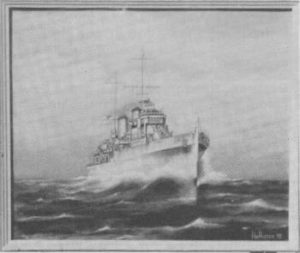- Author
- Ramsay, George
- Subjects
- Ship histories and stories, History - WW2
- Tags
-
- RAN Ships
- HMAS Perth I
- Publication
- December 1989 edition of the Naval Historical Review (all rights reserved)
HMAS Amphion, a 6″ modified ‘Leander’ Class Cruiser, was commissioned into the Royal Navy in June 1936, under Captain R. L. Burnett, OBE, RN. Of 6,980 tons, 72,000 hp, giving her a speed of 32.5 knots, she spent the next two years as Flagship on the African Station, based on the Cape of Good Hope. After re-fitting at Simonstown late in 1937, Amphion departed Simonstown in October 1938, and returned to England – Spithead, then to Portsmouth to ‘pay-off’, and to refit.
Following an agreement between the British and Australian Governments, for the purchase of Amphion for the Royal Australian Navy, on the 29th June, 1939, the cruiser commissioned into the RAN as HMAS Perth, at Portsmouth under the Command of Captain H. B. Farncomb, MVO, RAN.

(Artist: Hollister, 1978)
HMAS Perth’s brief period of peace time provided a visit to New York in America in early August, before World War II commenced her active duty, first in the Caribbean Sea, September, 1939, then to the Atlantic, before returning to Australia in April, 1940. After, a short period in home waters, Captain Bowyer-Smythe, RN, assumed command of Perth, and next the ship proceeded to the Mediterranean, and after relieving Sydney, Perth saw actions across the Eastern Mediterranean-Malta, Greece, Crete, Matapan and the Syrian Campaign before again returning to Australia in August, 1941.
In another change of command, after being flown ‘home’ from his previous command in HMAS Stuart, Captain H. M. L. Waller, RAN, now takes Perth to the Western Pacific, and the Battles of Java Sea, and later Sunda Strait.
At 1400 on the 26th of February, 1942, Perth was assigned to join an ABDA (Australia – British – Dutch – American) Force, and on the fateful night of February 28th, whilst proceeding South down through the Sunda Strait was sunk, with the USS Houston, after the two allied cruisers had run into an entire Japanese Invasion Force, off St. Nicholas Point off the North West end of Java, in 39 Fathoms of water, at 0025 on March 1st, 1942.
Of her complement of 680, only 320 were later picked out of the water by the Japanese and of these 105 were to die as prisoners of war. Only 229 returned to Australia.
In the book, ‘Out of the Smoke’, by Ray Parkin (Hogarth Press – London, 1960), he relates to some experiences of the action, and later of the survivors who eventually made land amid debris and oil in their initial escape. The book mainly relates to a ‘boat party’, who, after reaching shore, though suffering many privations and hazards on coral infested shorelines, managed to ‘rescue’ a lifeboat off a coral reef – then proceeded to equip it with oars, a sail and a mast, barricoes for water, together with a meagre find of biscuits, before setting sail down the Western end of Java, passing around Java Head, then generally sailing Eastward, along the Southern side of Java to eventually reach the port of Tjilatjap. Alas, after their sixteenth day at sea, the Port of Tjilatjap was now in Japanese hands, and they were captured and made POWs. They were moved to Singapore, before being sent to work on the infamous ’Burma-Siam’ Railway for one year and ten months under very inhuman conditions, going on to Ohama in Japan, and working in the coal mines there. (Ohama was situated between Hiroshima and Nagasaki, where the atomic bombs were dropped on Japan.)
Eventually, the ‘Boat Party’ was rescued by Allied Forces after some three and a half years in captivity and returned to Australia in October, 1945.
On a sail, which they had salvaged from that lifeboat which sailed them to captivity (the craft was given the name HMAS Anzac during the voyage), the ‘Boat Party’ drew – ‘To the memory of the gallant ship HMAS Perth‘.
That sail now hangs in the Royal Australian Navy Memorial Chapel at Flinders Naval Depot, Victoria.




